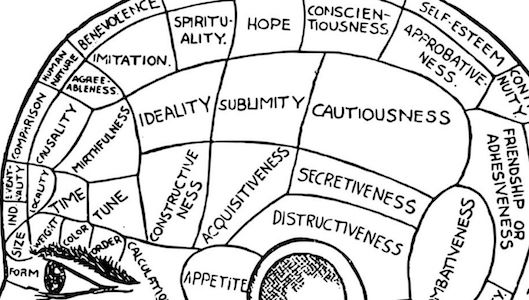Abstract: Stratium is a theory of mind as a multi-tiered system adding layers of meaning. There is no homunculus to read the result, making it necessary to say that these levels themselves read their constitution and “thicken”, degree by degree, the phenomenon called “consciousness”. To this teleological and functional theory is added an ontological theory, showing how the networks are anatomically concentrated at the base of the neural hierarchy, and very dispersed at the upper levels. ‘Stratium’ is a contraction of ‘strata’ and ‘atrium’.
Photons for a face
Stratium is a theory of mind as a multi-stage system adding levels of meaning. Let’s take the example of visual processing. Starting from the retinal stimuli: Receptor cone: ‘I am a point’. Neuron of the 1st hierarchical level, grouping the signals of the cones: ‘I am a line’. 2nd level: ‘I draw eyes nose mouth’ 3rd: ‘I am a face’ 4th: ‘I am a known person’ 5th: ‘I play such a role in society’, etc. Levels are arbitrary and simplified. Gateways to other aggregates of criteria are multiple, producing a particularly complex hierarchy in the immense neural skein.
Essential point: each level of representation has relative independence. Reason for the use of the pronoun ‘I’ in the previous description. A representation is physically a schema of activated neurons. A schema, not just a group. An enabled group includes multiple schemas, corresponding to multiple surimposed representation levels. By their position in the network and their connections neurons create a depth of information. A complex hierarchy reproduced by artificial AI neurons. How exactly does this depth add meaning? No one understands it yet. Complex networks are black boxes. Light points at the entrance, image of a person at the exit.
No homunculus to look at
I draw your attention to another essential point: In the brain there is no user who retrieves the result of AI. Exit is our conscious experience. The activation of networks at the complex top is enough to create the phenomenon of mentally existing. Unlike the AI programmer, the neuroscientist observing neural excitation in fMRI does not wonder whether the brain is conscious or not. He knows this without the need to question him. As a brain too, he experiences the same thing.
The relationship between a neural pattern and the stimuli it receives is a two-way. The schema is awakened by the regularities that created it. Direction stimuli > schema, influence of reality on thought. But the schema also activates autonomously, due to spontaneous excitations. The more it is solicited, the more it reappears in the following minutes, even in the absence of stimuli. Or it is the activation of the larger sets to which it belongs that awakens it again.
Intention and forgetfulness
Thus a representation does not exist only in the presence of the external reality that corresponds to it. It seeks itself in the external reality. Intention to exist. The more it is solicited, the more this intention is strengthened and expands its relationships. Conversely, it slowly fades away when it is no longer there. Oblivion.
Where are the networks located? At the first levels of sensory processing, which I call the “bottom” of the Stratium, anatomical localization is easy: the groups are concentrated around sensory afferents, neurons united by short and fast bonds. The visual image is formed instantly. No need to think about it.
Map of cerebral automatisms
This concentration of patterns allowed neurologists to map brain areas specialized in sensorimotor functions. Here is a very classic one:

This card is faithful for the most basic functions. Localized neural damage leads to paralysis in a specific place, language disorder, defect in the visual field, etc. The same is not true for higher functions.
No card for higher thoughts
Networks continue to self-organize into hierarchical levels. They mix simple and more complex meanings, expanding their field. Anatomical extension also increases. A higher pattern includes fibers between distant areas. The awakening of the complete scheme is delayed. Complex thinking, at the top of the Stratium, is slower.
An anatomical map of the upper networks is therefore much less simple. It is a skein specified only by descending to the scale of the neuron. Nothing to do with the simplistic illustration below:

Even with a very fine fMRI it is difficult to isolate a “thought”. MRI does not discern the depth of information. A thought takes on a different appearance depending on whether it has self-generated (spontaneous neural excitation), responds to another abstraction, or is formed in response to sensory stimuli (joint excitation of these areas).
When a thought is searched on an fMRI, neurons excited at a great distance from the main focus, which seem to parasitize the image, can instead have a crucial role. Thought amputated of important content if they are not turned on.
Upward look of the collective of stimuli
Using the upward look on our Stratium, that of neural self-organization, we thus see the action of stimuli dispersing throughout the entire brain, on increasingly extensive networks, involving a smaller number of neurons with longer axons. The upward look shows the collective neural origin of thought.
‘Stratium‘ is a term coined on ‘strata’ and ‘atrium’. Here is an illustration with an atrium in upward look: tiered space with a multitude of offices/tasks with little specialization at the first levels, surmounted by more general services/functions, up to the less numerous but brilliant conscious reflections:

Downward look of the fusion
With a downward look, we understand that conscious experience is fusional. The highest neurons in the hierarchy are integrators. They symbolize sophisticated thinking by their position in the higher schemes. The stimulation of a single neuron, on this stage, awakens the complete image, by the connections it establishes. Thus is explained the theory of the “grandmother neuron“, as well as the “Jennifer Aniston neuron“, a celebrity that appeared in the guinea pig’s consciousness by stimulation of a single neuron.
These highly integrative neurons, when stimulated, trigger a fusional impression. Conversely, if you stimulate a 1st rank visual neuron, you only trigger a white point, almost invisible, in the guinea pig’s visual field.
Illustration of the Stratium, downward look: the observer, fusion at the top, contemplates the tiny elements that form his impressions, whose details he perceives if he focuses his attention:

Hierarchy of networks, not neurons
Be careful, the hierarchy concerns symbolic networks and not individual neurons. A neuron can belong to several distant networks in the hierarchy. It is relay from the lower network to the upper and vice versa. From the 2nd rank the symbolic weight of neurons begins to diverge. They are excited jointly but one counts for the activation of a higher scheme and the other does not.
Neuroscientists thus identify visual neurons responding to particular faces. They are not located in the same place as the ‘Jennifer Aniston’ (median temporal lobe). Two distant ends of a single symbolic scheme. The studies cited confirm the hierarchical gap. Visual neurons respond to all faces, regardless of the person. They do this quickly (150ms), being close to 1st rank neurons. While the ‘Jennifer Aniston’ neurons respond later (300ms) but by integrating more criteria (identification of the person).
A paradigm to be straightened out
Stuck in the horizontal paradigm of the mind (vast single neural system) still in vogue, neuroscientists compete for the pre-eminence of this or that nucleus of neurons in a higher function. In the hierarchical paradigm of Stratium, all neurons in the scheme must be activated so that they awaken the complete representation, regardless of their position in the brain.
Thus the isolated activation of visual neurons produces an impersonal face. The joint activation of ‘Jennifer Aniston’ neurons surimposes the person. If the neuron ‘Jennifer Aniston’ is excited without the participation of visual neurons, you have the name of the actress but not her face. I’m simplifying, because it’s content in the middle of a fusion. The guinea pig only feels the difference by examining the details of his ‘Jennifer Aniston’ thought.
And the phenomenon of consciousness?
At this point in my explanation, Stratium is a theory of depth of information explaining the complexity of mental impressions. Close to Giulio Tononi’s Integrated Information Theory (IIT), which makes this depth the parameter of consciousness (Phi). But consciousness is not yet explained as a experienced phenomenon.
The other great scientific theory of consciousness, Stanislas Dehaene’s Global Workspace (GWT), does no better. It bases consciousness on the re-entries of stimulations between parts of the same neural space, which would thus be observed between them. But such interactions are observed between many other neural areas without them generating consciousness. Nothing explains the particular quality of this phenomenon.
So you will read with interest the rest, now that you are in possession of the physical bases 🙂 How does Stratium explain the phenomenon of consciousness?
*
CONSCIOUSNESS summary
Newer Stratium Overview for Professional Philosophers and Neuroscientists

